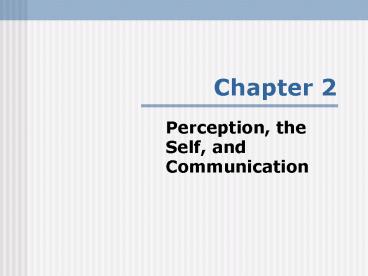Perception, the Self, and Communication - PowerPoint PPT Presentation
1 / 23
Title:
Perception, the Self, and Communication
Description:
how self-fulfilling prophecies influence behaviour. ... how self-fulfilling prophecies can lead either to more satisfying or to less ... – PowerPoint PPT presentation
Number of Views:178
Avg rating:3.0/5.0
Title: Perception, the Self, and Communication
1
Chapter 2
- Perception, the Self, and Communication
2
After studying the material in this chapter. . .
- You should understand
- how common perceptual tendencies and situational
factors influence perception. - the influence of culture on perception and the
self-concept. - the importance of empathy in communication.
- the communicative influences that shape the
self-concept.
3
After studying the material in this chapter. . .
- You should understand
- how self-fulfilling prophecies influence
behaviour. - how the process of identity management can result
in presentation of multiple selves. - the reasons for and the ethical dimensions of
identity management.
4
After studying the material in this chapter. . .
- You should be able to
- explain how the tendencies outlined in this
chapter have led you to develop distorted
perceptions of yourself and others. - use perception-checking and empathy to be more
accurate in your perceptions of others behaviour.
5
After studying the material in this chapter. . .
- You should be able to
- identify the ways you influence the self-concepts
of others and the ways significant others
influence your self-concept. - identify the communication-related
self-fulfilling prophecies that you have imposed
on yourself, that others have imposed on you, and
that you have imposed on others.
6
After studying the material in this chapter. . .
- You should be able to
- describe the various identities you attempt to
create and the ethical merit of your identity
management strategies.
7
Chapter highlights
- Our perceptions of others shape the way we
communicate with them. Several factors influence
these perceptions - our success at constructing shared narratives
through communication - our tendency to make several perceptual errors
8
Chapter highlights
- factors arising from our own experience and from
our prior relationship with that person - our cultural background
- our ability to empathize
9
Chapter highlights
- The skill of perception-checking can help us
clarify mistaken perceptions, leading to a shared
narrative and smoother communication.
10
Chapter highlights
- Communication depends on the way we perceive
ourselves, as well as others. You will appreciate
the importance of the self as you read about - how communication shapes the self-concept.
- the way culture shapes our self-perceptions.
11
Chapter highlights
- the role of personality in shaping our
perceptions. - how self-fulfilling prophecies can lead either to
more satisfying or to less productive
communication.
12
Chapter highlights
- As Chapter 1 explained, one reason we communicate
is to persuade others to view ourselves as we
want to be seen. - To understand how this principle of identity
management operates, Chapter 2 explains - the difference between perceived and presenting
selves.
13
Chapter highlights
- how we communicate to manage our identities, via
both face-to-face and mediated channels. - reasons why we communicate to manage our
identities.
14
Perceiving others
- Narratives and perception
- Common perceptual tendencies
- We often judge ourselves more charitable than we
judge others. - We are influenced by what is most obvious.
- We cling to first impressions, even if wrong.
15
Perceiving others
- We tend to assume that others are similar to us.
- We tend to favour negative impressions over
positive ones.
16
Perceiving others
- Situational factors influencing perceptions
- Relational satisfaction
- Degree of involvement with the other person
- Past experience
- Expectations
17
Perceiving others
- Social roles
- Knowledge
- Self-concept
- Perception and culture
- Empathy and perception
- Dimensions of empathy
- Perception-checking
18
Perceiving the self
- Self-concept defined
- Communication and development of the self
- Culture and the self-concept
- The self-concept, personality, and communication
- The self-fulfilling prophecy
19
Table 2.1
20
Figure 2.1
- The relationship between the self-concept and
behaviour
21
Identity management
- Characteristics of identity management
- We strive to construct multiple identities.
- Identity management is collaborative.
- Identity management can be conscious or
unconscious. - People differ in their degree of identity
management.
22
Table 2.2
23
Identity management
- Why manage impressions?
- How do we manage impressions?
- Face-to-face impression management
- Impression management in mediated communication
- Impression management and honesty































